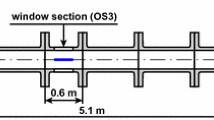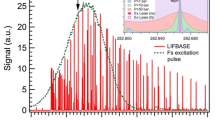Abstract
The flame displacement speeds in turbulent premixed flames have been measured directly by the CH double-pulsed planar laser-induced fluorescence (PLIF). The CH double-pulsed PLIF systems consist of two independent conventional CH PLIF measurement systems and laser beams from each laser system are led to same optical pass using the difference of polarization. The highly time-resolved measurements are conducted in relatively high Reynolds number turbulent premixed flames on a swirl-stabilized combustor. Since the time interval of the successive CH PLIF can be selected to any optimum value for the purpose intended, both of the large scale dynamics and local displacement of the flame front can be discussed. By selecting an appropriate time interval (100–200 μs), deformations of the flame front are captured clearly. Successive CH fluorescence images reveal the burning/generating process of the unburned mixtures or the handgrip structures in burnt gas, which have been predicted by three-dimensional direct numerical simulations of turbulent premixed flames. To evaluate the local flame displacement speed directly from the successive CH images, a flame front identification scheme and a displacement vector evaluation scheme are developed. Direct measurements of flame displacement speed are conducted by selecting a minute time interval (≈30 μs) for different Reynolds number (Re λ = 63.1–115.0). Local flame displacement speeds coincide well for different Reynolds number cases. Furthermore, comparisons of the mean flame displacement speed and the mean fluid velocity show that the convection in the turbulent flames will affect the flame displacement speed for high Reynolds number flames.












Similar content being viewed by others
References
Allen MG, Howe RD, Hanson RK (1986) Digital imaging of reaction zones in hydrocarbon-air flames usin planar laser-induced fluorescence of CH and C2. Opt Lett 11:126–128
Baum M, Poinsot TJ, Haworth DC, Darabiha N (1994) Direct numerical simulation of H2/O2/N2 flames with complex chemistry in two-dimensional turbulent flows. J Fluid Mech 281:1–32
Bockle S, Kazenwadel J, Kunzelmann T, Shin D-I, Schulz C, Wolfrum J (2000) Simultaneous single-shot laser-based imaging of formaldehyde, OH, and temperature in turbulent flames. Proc Combust Inst 28:279–286
Candel SM, Poinsot TJ (1990) Flame stretch and the balance equation for the flame area. Combust Sci Technol 70:1–15
Carter CD, Donbar JM, Driscoll JF (1998) Simultaneous CH planar laser-induced fluorescence and particle imaging velocimetry in turbulent nonpremixed flames. Appl Phys 66:129–132
Choi GM, Yang JS, Kim DJ, Tanahashi M, Miyauchi T (2007) Estimations of local heat release rate in the methane–air premixed flames. Thermochim Acta 455:34–39
Clavin P (1985) Dynamic behavior of premixed flame fronts in laminar and turbulent flows. Prog Energy Combust Sci 11:1–59
Clavin P (2000) Dynamics of combustion fronts in premixed gases: from flames to detonations. Proc Combust Inst 28:569–585
Dyer MJ, Crosley DR (1985) Fluorescence Imaging for Flame Chemistry. Proc Int Conf Laser 84:211–218
Echekki T, Chen JH (1996) Unsteady strain rate and curvature effects in turbulent premixed methan-air flames. Combust Flame 106:184–202
Hanson RK (1986) Combustion diagnostics: planar imaging techniques. Proc Combust Inst 21:1677–1691
Haworth DC, Poinsot TJ (1992) Numerical simulations of Lewis number effects in turbulent premixed flames. J Fluid Mech 244:405–436
Hult J, Meier U, Meier W, Harvey A, Kaminski CF (2005) Experimental analysis of local flame extinction in a turbulent jet diffusion flame by high repetition 2-D laser techniques and multi-scalar measurements. Proc Combust Inst 30:701–709
Kaminski CF, Hult J, Alden M (1999) High repetition rate planar laser induced fluorescence of OH in a turbulent non-premixed flame. Appl Phys B 68:757–760
Kido H, Nakahara M, Nakashima K, Hashimoto J (2002) Influence of local flame displacement velocity on turbulent burning velocity. Proc Combust Inst 29:1855–1861
Kumar S, Banerjee S (1998) Development and application of a hierarchical system for digital particle image velocimetry to free-surface turbulence. Phys Fluids 10:160–177
Kychakoff G, Paul PH, van Cruyningen I, Hanson RK (1987) Movies and 3-D images of flowfields using planar laser-induced fluorescence. Appl Opt 26:2498–2500
Law CK, Sung CJ (2000) Structure, aerodynamics, and geometry of premixed flamelets. Prog Energy Combust Sci 26:459–505
Mansour MS, Peters N, Chen YC (1998) Investigation of scalar mixing in the thin reaction zones regime using a simultaneous CH-LIF/Rayleigh laser technique. Proc Combust Inst 27:767–773
Nada Y, Tanahashi M, Miyauchi T (2004) Effect of turbulence characteristics on local flame structure of H2-air premixed flames. J Turbulence 5:16
Nygren J, Richter M, Hult J, Kaminski CF, Alden M (2001) Temporally resolved single-cycle measurements of fuel- and OH-distributions in a spark ignition engine using high speed laser spectroscopy. In: Fifth intl symp on diagnostics and modeling of combustion in internal combustion engines, pp 572–580
Peters N (1999) The turbulent burning velocity for large-scale and small-scale turbulence. J Fluid Mech 384:107–132
Peters N (2000) Turbulent combustion. Cambridge Press, London
Poinsot TJ, Echekki T, Mungal MG (1992) A study of the laminar flame tip and implications for premixed turbulent combustion. Combust Sci Technol 81:45–73
Pope SB (1988) The evolution of surfaces in turbulence. Intl J Eng Sci 26:445–469
Schefer RW, Namazian M, Filtopoulos EEJ, Kelly J (1994) Temporal evolution of turbulence/chemistry interactions in lifted, turbulen-jet flames. Proc Combust Inst 25:1223–1231
Seitzman JM, Haumann J, Hanson RK (1987) Quantitative two-photon LIF imaging of carbon monoxide in combustion gases. Appl Opt 26:2892–2899
Seitzman JM, Miller MF, Island TC, Hanson RK (1994) Double-pulse imaging using simultaneous OH/acetone PLIF for studying the evolution of high-speed reacting mixing layers. Proc Combust Inst 25:1743–1750
Sinibaldi JO, Driscoll JF, Mueller CJ, Donber JM, Carter CD (2003) Propagation speeds and stretch rates measured along wrinkled flames to assess the theory of flame stretch. Combust Flame 133:323–334
Smooke MD, Xu Y, Zurn RM, Lin P, Frank JH, Long MB (1992) Computational and experimental study of OH and CH radicals in axisymmetric laminar diffusion flames. Proc Combust Inst 24:813–821
Tanahashi M, Fujimura M, Miyauchi T (2000) Coherent fine-scale eddies in turbulent premixed flames. Proc Combust Inst 28:529–535
Tanahashi M, Ootsu M, Fukushima M, Miyauchi T (2002) Measurement of coherent fine scale eddies in. turbulent mixing layer by DPIV. Eng Turbul Model Meas 5:525–534
Tanahashi M, Murakami S, Choi GM, Fukuchi Y, Miyauchi T (2005) Simultaneous CH–OH PLIF and stereoscopic PIV measurements of turbulent premixed flames. Proc Combust Inst 30:1665–1672
van Oijen JA, Groot GRA, Bastiaans RJM, de Goey LPH (2005) A flamelet analysis of the burning velocity of premixed turbulent expanding flames. Proc Combust Inst 30:657–664
Watson KA, Lyons KM, Carter CD, Donbar JM (2002) Simultaneous two-shot CH planar laser induced fluorescence and particle image velocimetry measurements in lifted CH4/air diffusion flames. Proc Combust Inst 29:1905–1912
Westerweel J, Dabiri D, Garib M (1997) Effect of a discrete window offset on the accuracy of cross-correlation analysis of digital PIV recordings. Exp Fluids 23:20–28
Williams FA (1985) Combustion theory. Benjamin Cummings, California
Williams FA (2000) Progress in knowledge of flamelet structure and extinction. Prog Energy Combust Sci 26:657–682
Acknowledgments
This work is partially supported by Grant-in-Aid for Scientific Research (A) (No.15206023) of Japan Society for the Promotion of Science.
Author information
Authors and Affiliations
Corresponding author
Rights and permissions
About this article
Cite this article
Tanahashi, M., Taka, S., Shimura, M. et al. CH double-pulsed PLIF measurement in turbulent premixed flame. Exp Fluids 45, 323–332 (2008). https://doi.org/10.1007/s00348-008-0482-8
Received:
Revised:
Accepted:
Published:
Issue Date:
DOI: https://doi.org/10.1007/s00348-008-0482-8




